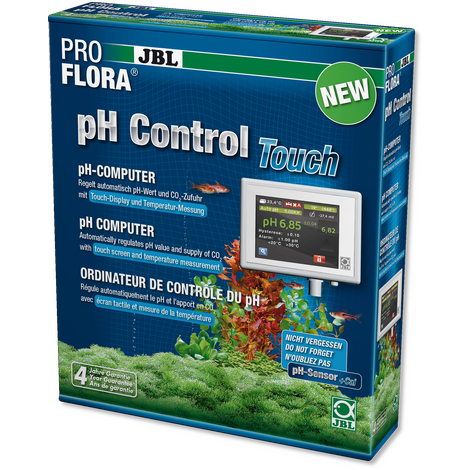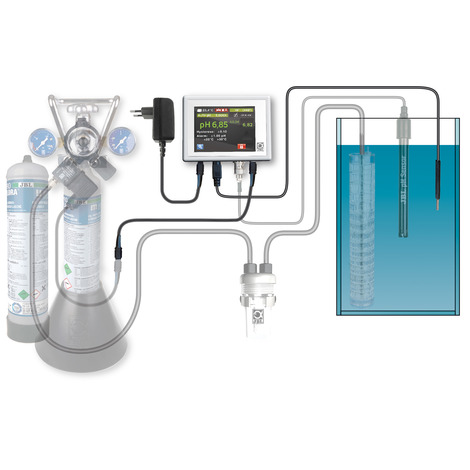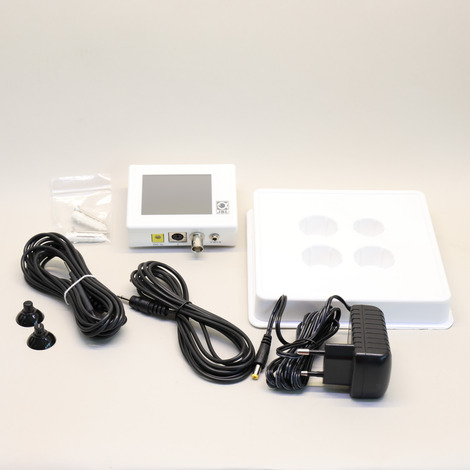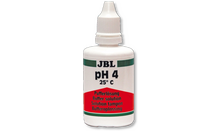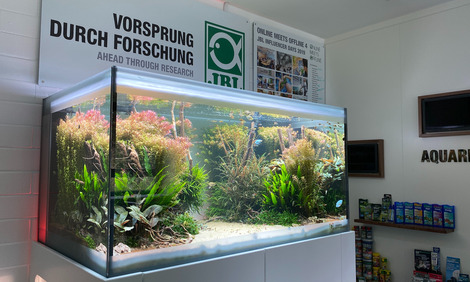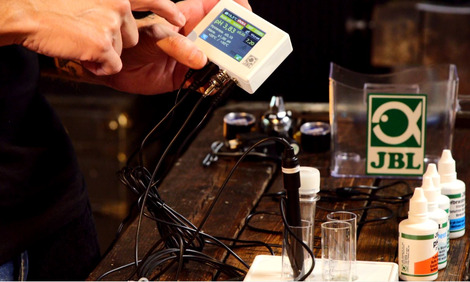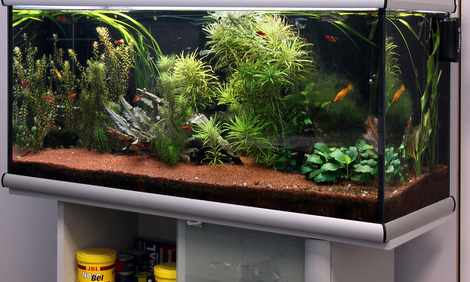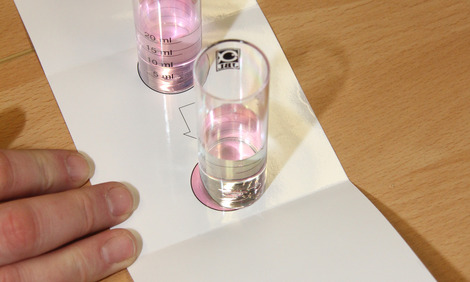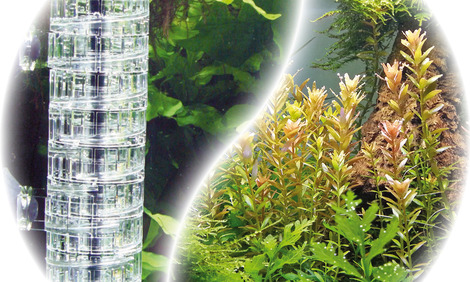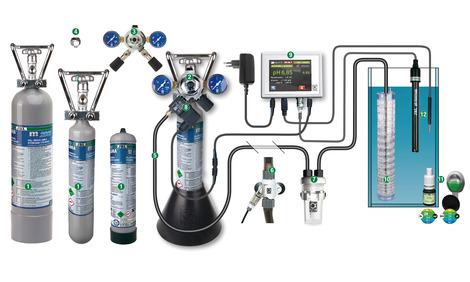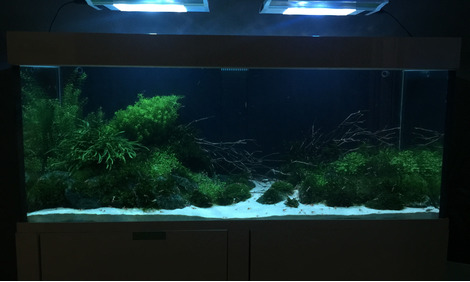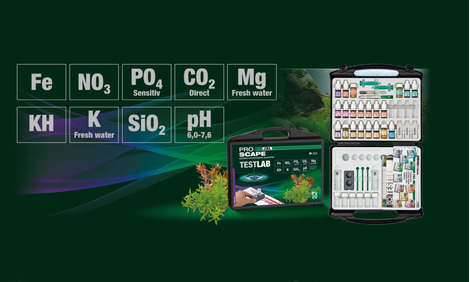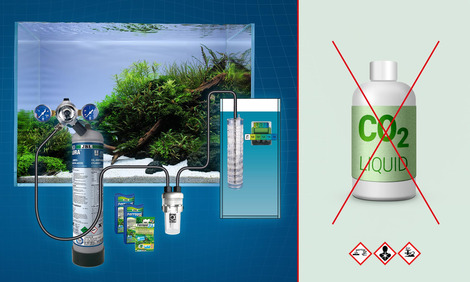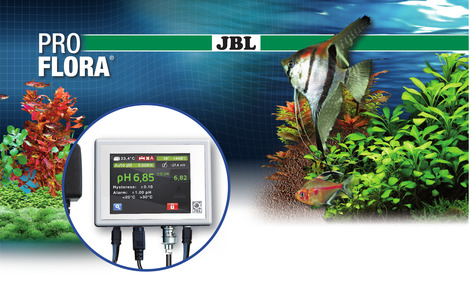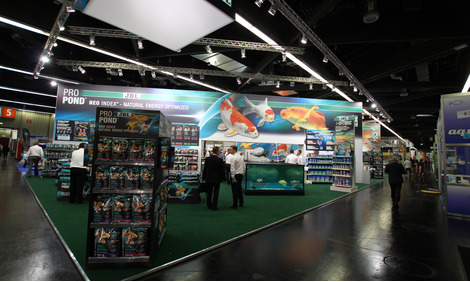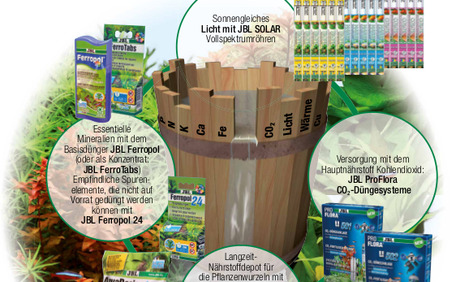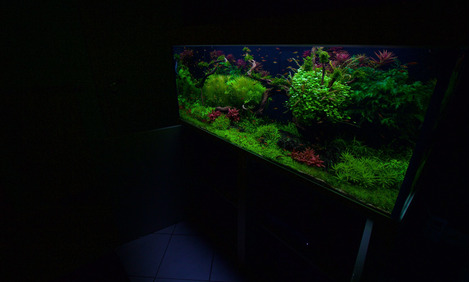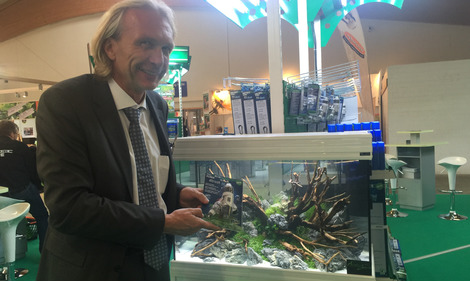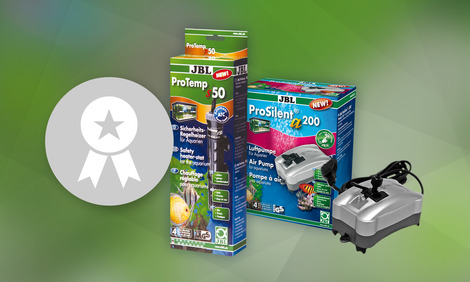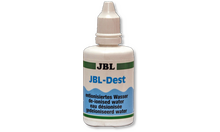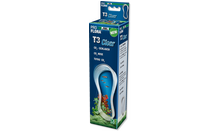Healthy fish thanks to an ideal pH value
The acidity defines the pH value of the water. It needs to be constantly checked and adjusted as necessary to maintain the health of the fish and plants. The correct pH value depends on the fish stock of the aquarium. The wrong pH value can cause stress and diseases.
Technical information
Incl. temperature sensor,
Modern graphic display with touchpad, sensor check during each calibration, error diagnosis after failed calibration, permanent display: pH actual/set value, sensor voltage, temperature, calibration reminder in days/hours, valve status, precision of measurement, set point adjustment: freely selectable or automatic calculation by means of auto pH, automatic temperature compensation during measuring and calibration, hysteresis freely selectable (upper and lower deviation from switching point), password key lock, alarm function pH (alarm range), alarm function temperature (range and set point alarm), selectable valve status, language selection: D/EN/F/NL/I/DK/E/P, reset function, universal power unit suitable for all common mains voltages worldwide.
Why a pH control?
If you want to automatise the CO2 supply, you can connect a pH computer (JBL PROFLORA pH-Control Touch) instead of a timer for the night shut-off. You’ll need to enter the carbonate hardness (KH) of your aquarium water once and then the computer will calculate the appropriate pH value, which is adjusted by adding CO2. Then the computer steers the solenoid valve and adds as much CO2 as necessary until the calculated or desired pH value is reached. The solenoid valve is then closed and opened again so that the pH value remains stable. The pH measurement of the water is done by a pH electrode, which is NOT included in the set and needs to be purchased separately. This ensures that you do not receive an old electrode in the set, but always a brand-new one!
JBL PROFLORA pH-Control Touch
Measurement and control computer for control of CO2/pH
PROFLORA CO2 CONTROL
- Promotes plant growth and leads to lively fish: measurement and control computer with touchpad for the high-precision calculation and control of the best pH value in aquariums
- Connect sensors (pH sensor not included), set desired values in menu, connect with solenoid valve (not included)
- Digital measurement and control technology: graphic display, direct user interface, separate sensors for pH value and temperature
- Compares desired and actual pH value and controls the CO2 supply with solenoid valve (not included)
- Package contents: CO2 controller with touch display; incl. wall mount, power supply unit, temperature sensor with 2 suction cups and connection cable for the solenoid valve, cuvette holders for calibration liquids
You may also be interested in
JBL PROFLORA pH-Control Touch
Properties
| Animal species: | Arowana, Axolotl, Barbels, Bettas, Bichirs/reedfish, Blowfish, Catfish, Cichlids (South America), Crayfish, Danions, Discus, Dwarf shrimps, Flowerhorn, Goldfish, Gouramis, Guppy, Juvenile fish, Killifish, Livebearers, Loaches, Panchaxes, Rainbowfish, Snails, Spiny eels, Tetra, Veiltails, freshwater butterflyfish |
| Animal size: | For all animal sizes |
| Animal age group: | All aquarium fish |
| Volume habitat: | For all aquariums |
| Material: | plastic (PC) / semiconductor |
| Colour: | white / black |
Electronic label / illuminant
| Mercury: | No |
| Dimmable: | No |
Technical Data
All pH sensors (electrodes) are wear parts and are subject to natural ageing. JBL grants a 6-month guarantee if the sensor is put into operation before the stated MIN date. The purchase receipt serves as proof.
The password to unlock the keylock is “7422“. A printing error caused another code to appear in some instructions. We have since corrected this.
A BNC connector is needed.
It is difficult to give a precise answer without information about the sensor, particularly the age of the sensor. Good sensors have deviations in the range from 0.02 to 0.05 pH levels when calibrating.
The input voltage differs for each sensor, as each sensor has its own individual properties. For the majority of our sensors, it is between -30 and +30 mV at pH 7.
Both input voltages (pH 7 and pH 4) are important when assessing the quality of a sensor. The greater the difference between these two values, the better the sensor and the precision of the measurement and control. The differences should be over 140-150 mV.
The temperature sensor should always be used during calibration. The pH level varies according to temperature, so that it is always best to measure the pH level with temperature compensation. The deviation is between 20 and 30 °C, 0.17 pH levels, and the relationship is nonlinear.
The message INSTAB indicates: instable sensor voltage: the sensor tip is dirty, the electrolyte has leaked from the sensor, the sensor tip is damaged.
Remedy: Clean the sensor head (see the respective instruction), put the sensor into the storage solution for 24 hours and repeat the calibration. If this does not work the sensor is defective and should be replaced.
The cause can probably be fixed quite easily. The protective cap of the pH sensor needs to be removed before insertion into the aquarium / before the calibration, to carry out control/calibration correctly. The protective cap serves as storage and “reactivation” of the sensor with the storage liquid. It has to be removed for use inside the aquarium and during the calibration because no water from outside can pass through. If the controller still displays an error, even after the removal of the protective cap, please read the FAQ with the several error messages in detail.
The message OFFSET indicates: The sensor voltage at pH 7.00 is outside the limit value, the sensor is too old, the cable is defective, no sensor is connected or the calibration has been performed with buffer 4 solution.
Remedy: Check the sensor cable for any signs of damage and repeat the calibration. Take care to use the buffer solution correctly. If this does not work, replace the sensor and calibrate again.
If the pH value is subject to greater fluctuation, this is an indication of interference from another electronic device. Ballasts in light bars, for instance, create an electromagnetic field if they are not shielded against interference. This can disturb the sensitive sensor. When you unplug the power plug from the outlet the pH value should suddenly stabilise. You can carry this process out with every electrical device in the aquarium to find the source of interference.
By using separated power-carrying cables further disturbances can be avoided. Separating electrical circuits may also prove to be a good idea. The JBL pH Control Touch units are manufactured and tested in accordance with EMC directives and do not interfere with other technical items. Thus the JBL pH Control Touch does not expose wearers of pacemakers to any danger.
If another technical item disturbs your pH control, then it has not been electromagnetically shielded in accordance with this technical standard.
This message indicates that the potential difference per full pH unit is smaller than 30 mV. The pH sensor is either too old, defective or was accidentally calibrated twice with the same buffer solution.
Remedy: Repeat the calibration and take care to use the buffer solution correctly. If this does not work, connect a new sensor and calibrate again.
No, the pH sensor is meant. It is located in a protective cap which is filled with a storage solution. Before the calibration the pH sensor needs to be taken out of this protective cap by loosening the screw connection and to be immersed, without the cap (and storage solution), into the aquarium water.
The pH sensor transmits a voltage to the measuring device, which convert the voltage into the pH value.
This voltage does NOT remain constant throughout the service life of the sensor! It needs to be calibrated regularly. The device is thus informed about the age-related change in voltage and can display reliable values again.
The calibration takes place at pH 7 and pH 4.
At pH 7 a new sensor transmits a voltage of 0 mV (+/- a few mV) to the measuring device. The more the voltage at pH 7 deviates from 0, the older the sensor is. The deviation can occur at + or -. At a deviation of more than +40 or -40 mV the device rejects the sensor.
The error message OFFSET appears.
NOTE: The same error message appears if you accidentally begin to calibrate at 4!!
At pH 4 the sensor transmits a voltage of about +186 mV (when 7 is at 0 mV). This means that between the single steps (4-5; 5-6 and 6-7) there is in each case a difference of about 62 mV. The smaller this difference, the older the sensor. With differences below 30 mV the device rejects the sensor.
The error message DELTAV appears.
NOTE: The same error message also appears, when you accidentally calibrate twice at 7!!
IMPORTANT: Rejected sensors can often be brought “back into operation” if you soak them intensively in storage solutions (for several days)!
In the menu you have the chance to choose the interval before the next calibration reminder. The following calibration intervals are available:
30 days
45 days
60 days
However it is highly recommended not to select the 60 days setting, since each pH sensor wears continuously and the measured values become subject to change. Thus the more often you carry out a calibration the more reliable are the measurement results.
The JBL ProFlora pH Control Touch has the following dimensions: W x H x D: 89 mm x 67 mm x 25 mm. Including the connections the height is 78 mm.
You also need to allow about 4-5 cm for the connection area under the control unit to ensure an easy installation.
Although it is not possible to mount the controller directly to the wall, it can be mounted on a top-hat rail, which can then be fixed to a wall. The above mentioned depth includes the top-hat rail.
A display of N/A means that the pH controller is not receiving any input value. This may be due to the following:
1) There is no contact in the plug, perhaps caused by a slightly corrosive coating. Please check the contact points of the plug.
2) The temperature sensor is not connected.
Note: The JBL pH Control Touch can also be operated without a temperature sensor. In this case, the controller adjusts to a water temperature of 25 °C.
You need a separate soleniod valve (JBL ProFlora v002 or JBL PROFLORA CO2 VALVE) to control the CO2 supply. A further night switch-off for CO2 systems, controlled by a pH control unit is not needed, as the CO2 supply will not be turned on in the absence of CO2 consumption, or it will happen less frequently when CO2 degassing occurs at the water surface. That is why the control units do not need a timer
Reviews
0 Reviews
6 more reviews in other languages
6 Reviews in other languages
Ik heb twee JBL PROFLORA pH-Control Touch sets gekocht voor twee verschillende aquaria. De temperatuursensor wijkt (zelfs na het vervangen van door twee nieuwe temperatuursensoren) resp. 1,8 graden Celsius en 1,3 graden Celsius af. Aangezien de temperatuursensor een rol speelt bij de ijking van de PH-elektroden in beide aquaria via de JBL PROFLORA pH-Control Touch is feitelijk het hele systeem onbetrouwbaar. PH wijkt ook ongeveer 0,25 PH af t.o.v. een geijkte 'handmeter'. Je geeft een hoop geld uit, omdat je het goed wilt hebben, maar dat is het blijkaar na enkele jaren niet meer. JBL moet ofwel een betrouwbare computer en sensor maken en/of de mogelijkheid geven om de waarde van de sensor aan te passen. Toen de systemen nieuw waren viel me ook al direct op dat de temperatuursensoren niet in de buurt van de juiste waarde aangaven, maar ik realiseerde me destijds nog niet dat daarmee het hele systeem onbetrouwbaar is. Als je niet zit met 0,3 PH verschil dan kun je het systeem gewoon gebruiken en dan werkt het best goed, maar het feit dat het systeem net niet helemaal te vertrouwen is voelt met terugwerkende kracht niet prettig. Verder werkt het best goed, maar dus niet nauwkeurig en dat laatste verwacht je wel.
Bedienung 10/10
Installation Selbsterklärend
Einfach ein tolles Gerät!
Ich habe den PH Wert immer im Auge.
Tatsächlich hat mich die Alarmfunktion schon vor einem schlimmen Fauxpas bewahrt (Säuresturz durch KH0)
Solidna Niemiecka jakość i zarazem prostota i intuicyjna obsługa sprawia że to sprzęt najwyższej jakości
Super produit... je test le KH je le rentre dans l'ordinateur est il s'occupe de tout gérer le CO2 est le PH automatiquement. Très bon matos comme toujours avec JBL 😉
Sehr hilfreich einfache Bedienung man kommt schnell damit klar. Man kann deb Auto pH einstellen man kann auch das Ventil öffen oder schließen wie man es grade braucht. Einfacher geht's nicht 👍
Einfache Installation und eine super Hilfe bei der CO2 Düngung. Nie wieder ohne.
